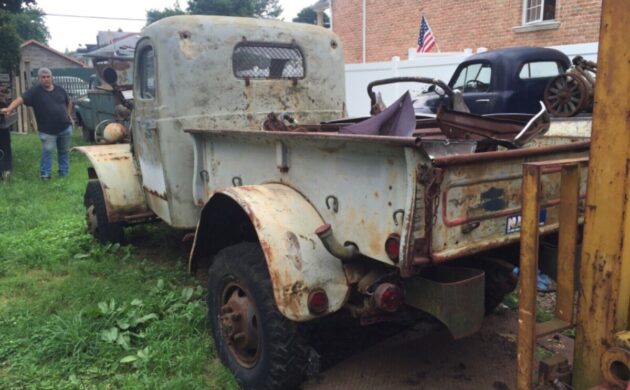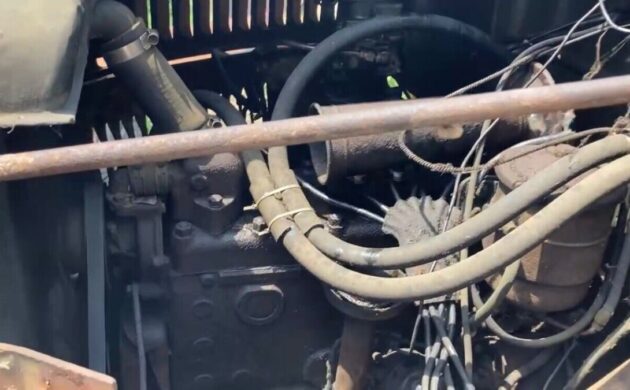With the war clouds of World War II forming, the United States quietly began building up our military for combat. A big part of that was trucks. The ability to move men and materiel from the factories to the bases and ports, and, ultimately, to the battlefield was crucial for success. Trucks like this 1941 Dodge WC12 for sale on eBay out of Bayside, New York weren’t as glamorous as fighter planes and battleships. However, as the war wore on trucks like this were just as vital to winning the war. At a current bid of $2,125 would this old soldier be the perfect low-cost restoration candidate?
War was the last thing that the people of 1930s America wanted. Memories were still fresh of the bloodbath that was World War I. The economy was still struggling to rebound out of the most severe depression the country had ever experienced, and our military strength was about on par with some Latin American countries. Everyone was aware of the growing problems in the Pacific and in Europe, but isolationism was the collective desire of a country weary of hard times.
Despite this, Franklin Delano Roosevelt and his administration began pushing to prepare for war. One aspect of this buildup was entering into contracts to build trucks for the military. Dodge was one of the companies to meet this challenge. The truck that emerged from design and testing would evolve for decades and become known as the Power Wagon much later. One of the first to emerge was the WC series of Dodge trucks. WCs took on a multitude of iterations, from closed cab pickups to a phaeton type vehicle called a command car. These distinctive command cars sadly became a favorite target for the Luftwaffe in the early days of the war as they almost always carried officers. Said officers quickly found less conspicuous transportation.
After Pearl Harbor, the buildup to support the war became almost unbelievable. So many men joined the military in response that some had to use broomsticks as substitutes for rifles in the many training camps that sprang up all over the United States. Production was halted on many civilian items like automobiles in order to begin manufacture of the necessities of war. As all of these factories started to come online the American soldier enjoyed an ever-growing advantage over his enemy. The vaunted German Wehrmacht was still using horses to move some of its weapons and supplies. While you cannot eat a Dodge truck, having a way to quickly and efficiently move things such as ammunition to the front lines was obviously a huge advantage. The edge that our factories at home gave our soldiers was a factor that contributed strongly to overall victory.
Decades later we find one of these Dodge WC series trucks sitting in a yard in New York. This truck is advertised as complete and original. It was started a few weeks ago and is said to sound good and have good oil pressure. As the picture shows below, it didn’t take too many high-tech tools to awaken this flathead Mopar engine from its slumber. Despite the engine running, there is rust in the cab and the truck’s fuel tank needs cleaning or replacement. A gravity type fuel tank was used to crank it up.
The good news is that there is nothing you cannot get in the way of parts for these vehicles. Steel Soldiers is a website that focuses on surplus military vehicles such as this one and can provide the support you would need for a project like this. Military vehicle enthusiasts are a tight knit and amazingly large bunch of enthusiasts that can frequently be seen displaying their vehicles at shows and rallies across the country. Mechanical parts can be found at the Vintage Power Wagons website along with a plethora of information about these beasts. A lot of the parts they sell are NOS military surplus parts that are still out there in amazing quantities so many years later. Once again, it is hard to comprehend just how much war material was produced for World War II and the subsequent Cold War era.
This truck will take a lot of work to bring it back to presentable condition. Mechanically, however, everything is straightforward to work on and is built to last. It would be great to see this truck back on the road to remind us of the sacrifices made both at home and overseas during World War II.
Do you have any stories of the World War II period that were passed down from family members? If so, please share them in the comments.








Good trucks, these were. I used to see lots of them around 50 years ago but their numbers have dwindled. I sometimes think it would be a lot of fun having one of these. Of course it would ride a lot rougher than I would care for. Just drive slower I guess. Could do a lot of work with one…
Couple things, 1st, I take a bit of sadness the author compares our military to some 3rd world country. WW1 was the first mechanized war, and we led the charge. It’s been debated, but we did win. This particular “soldier” probably was a surplus truck, and for some reason never got shipped. If the trucks weren’t blown to smithereens, they were dumped at sea on the way home. I believe, all army trucks had this style, mandated by the military, just their own drivetrains. It is unmistakably military to many rapidly dying, to younger folks, just an old truck. The people that had any connection with this truck in their family, long gone, and with it the memory of what this country did to survive. My old man told us “war stories” that left us unable to sleep. I wonder if the same could be done today?
There were a lot of guys in my Dad’s age group that didn’t care for fireworks because the ‘bang’ was reminiscent of something they’d rather forget. They’d celebrate Independence Day along with everyone else but when the fireworks came on they disappeared. A lot of Vietnam vets with similar attitudes…
You’re right, Geomechs, and PTSD has victims in every generation. Kids that came home from seeing action in Grenada,Panama, Kosovo, the Persian Gulf wars and of course Afghanistan + Iraq, to name a few..had a few on our team that could never completely readjust but we were able to help a few get started in the right direction.
Many more groups now out there now like Tunnels to Towers and Wounded Warriors but still too many vets out there drifting aimlessly.
On a totally different note, Howard A. once noted that these Power Wagon/WC’s when restored correctly will still be around to outlive the cockroaches after the Apocalypse!
Yes, this was the case with my maternal grandfather, a ww1 veteran and battlefield surgeon. My mother told me stories of how they celebrated the 4th of July. No fireworks but a couple cases of Nehi soda pop for the kids.
In 1937 the United States Army was rated at equivalent to Romania, You can look it up. It was still cavalry horses and mules. It would soon change.
I’ve no knowledge about trucks’ being blown up, but my late father often talked about seeing hundreds of them being dumped at sea from a CV at the end of the war.
The author is not incorrect in his characterization of the US military strength at the onset of WWII. He was not insulting the US; simply referencing a historical fact. Broadly accepted historical assessments of overall military strength of nations at the start of WWII rank the US at 16th. That’s a major reason why the US ranking of first by the end of the war is that much more remarkable, and a testimony to the efforts of the entire society in such a short time.
This truck may have served at a US base as most vehicles sent overseas were simply left there and used by occupation forces or donated to the rebuilding militaries of US allies.
Midwest Military in Minnesota also is a good source for WWII 1/2-ton and 3/4-ton Dodge WC parts. The ebay auction has been ended by the seller due to an error in the listing.
i went to iraq in 04, the TNARNG took dam near every piece of equipment we owned, when we left after our tour we left everything because it was deemed ‘contaminated’… took a couple years to rebuild our fleet… we were deployed again in 07 to kuwait, took our stuff, but if i remember we brought some of it back…
Thanks to you and all who served, especially on this weekend after Veterans day!
This is a WC military truck it’s not a Power Wagon the civilian PW came out in 46. The things to watch for on trucks like this have to do with how long it’s been since it moved. I say this because some of these have been parked in the same spot for 20 years or more and that means there are parts that haven’t been in oil for that amount of time. Bottom line is bearings, ring and pinions, transfer case and transmission will likely need to be taken fully apart and inspected and you will likely find pitted bearings which need replacement. Figure 3,000 dollars plus labor.
Been there done that!
I can attest to that, Karl. I’m in the antique truck supply business right now and I get calls daily asking for bearings, seals and other parts. Out west, there isn’t as much of a problem as the eastern part of the country because the climate is a lot drier. But it still happens. On the other hand, I’m somewhat surprised at how well some components have stood up. Got one customer in Alaska whose transmission managed to get contaminated with water. The bearings needed to be replaced but the gears all passed other than some small blemishes. And what he showed me at the beginning looked like he was about to scrap the entire unit. A llittle of elbow grease…
You are correct NH Dave.
But mr. made statements without researching, and instead was speaking from an opinion incorrectly held.
Truck is priced right to make it an affordable restoration.